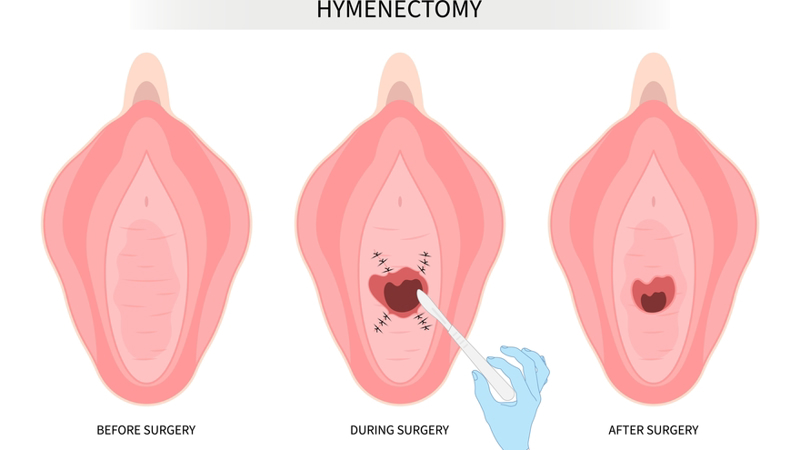Imperforate Hymen: Causes, Symptoms, and Treatment
Imperforate hymen, a congenital condition that affects some individuals with female reproductive anatomy, is a topic often shrouded in misconceptions and lack of awareness. In this comprehensive guide, we’ll delve into the details of imperforate hymen, exploring its causes, symptoms, and available treatment options.
What is an Imperforate Hymen?
Before we explore the underlying causes and symptoms, it’s essential to understand what an imperforate hymen is. The hymen is a thin membrane located at the opening of the vaginal canal. In some cases, this membrane may completely cover the vaginal opening, resulting in an imperforate hymen.

Structure of the Hymen
Discuss the normal structure of the hymen, emphasizing its role in female anatomy. Mention that in the case of an imperforate hymen, the membrane doesn’t have an opening.
Congenital Nature
Explain that an imperforate hymen is a congenital condition, meaning it’s present at birth. This can help dispel misconceptions and stigma surrounding the condition.
Impact on Reproductive Health
Briefly mention that an imperforate hymen can have implications for reproductive health, which will be explored further in the article.
Causes of Imperforate Hymen
Understanding the factors contributing to the development of an imperforate hymen is essential. While it’s a congenital condition, there are underlying causes worth exploring.
Role of Hormones
Discuss the role of hormones, specifically estrogen, during fetal development. Emphasize how hormonal imbalances can lead to an imperforate hymen.
Genetic Factors
Mention that imperforate hymen can have a genetic component, with a family history of the condition increasing the risk.
Rare Syndromes
Highlight that imperforate hymen can be associated with certain rare syndromes, although this is less common.
Symptoms of Imperforate Hymen
Identifying the symptoms of an imperforate hymen is crucial for early detection and prompt treatment. This section provides insights into the signs individuals may experience.
Menstrual Issues
Explain that one of the primary symptoms of an imperforate hymen is the absence of menstruation (amenorrhea) in adolescent girls. This occurs because menstrual blood is trapped behind the closed hymen.
Abdominal or Pelvic Pain
Highlight that some individuals may experience recurring abdominal or pelvic pain due to the accumulation of menstrual blood and pressure on the uterus.
Diagnosis and Medical Evaluation
Diagnosing an imperforate hymen involves a medical evaluation to confirm the condition and assess its severity.
Physical Examination
Explain that a healthcare provider will typically perform a physical examination, which may include a pelvic exam, to diagnose an imperforate hymen.
Imaging Studies
Mention that in some cases, imaging studies like ultrasound or MRI may be ordered to visualize the imperforate hymen and assess the extent of blockage.
Treatment Options
Treatment for an imperforate hymen aims to alleviate symptoms, restore normal menstrual function, and prevent complications.
Surgical Intervention
Explain that a common treatment approach involves a surgical procedure to create an opening in the hymen, allowing menstrual blood to flow out.
Recovery and Follow-Up
Discuss the recovery process post-surgery, including the importance of follow-up appointments with a healthcare provider.
Future Reproductive Health
Mention that, once treated, individuals with an imperforate hymen can usually expect normal reproductive health and menstruation.
Frequently Asked Questions (FAQs)
Q: What is an imperforate hymen?
A: An imperforate hymen is a congenital condition where the hymen completely covers the vaginal opening, leading to various symptoms.
Q: Are imperforate hymens common?
A: Imperforate hymens are relatively rare but can affect some individuals with female reproductive anatomy.
Q: What causes an imperforate hymen?
A: Imperforate hymens are typically caused by hormonal imbalances during fetal development, although genetic factors can also play a role.
Q: What are the common symptoms of an imperforate hymen?
A: Common symptoms include the absence of menstruation, abdominal pain, difficulty with tampon insertion, and back pain.
Q: Is an imperforate hymen painful?
A: It can cause discomfort and pain, especially as menstrual blood accumulates behind the closed hymen.
Q: How is an imperforate hymen diagnosed?
A: Diagnosis often involves a physical examination, including a pelvic exam, and may include imaging studies like ultrasound or MRI.
Q: Can an imperforate hymen be treated without surgery?
A: Surgical intervention is the most common and effective treatment, creating an opening in the hymen to alleviate symptoms.
Q: Is recovery after surgery for an imperforate hymen quick?
A: Recovery time varies, but individuals can usually expect a relatively quick recovery with proper post-operative care.
Q: Can an imperforate hymen affect future reproductive health?
A: Once treated, individuals can typically expect normal reproductive health and menstruation.
Q: Is it necessary to consult a specialist for imperforate hymen treatment?
A: Consulting a healthcare provider, particularly a gynecologist, is crucial for diagnosis and tailored treatment.
Conclusion:
Understanding and addressing an imperforate hymen is vital for individuals who may experience its symptoms. While it can be a source of distress, the condition is both diagnosable and treatable. In this section, we summarize the key takeaways from the article.




